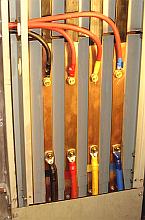|
But Imbalance does not just have to occur at the source. The final leg of the distribution can be just as at fault as the start. At 230VAC there is a lot of attention paid to conductors being beefy enough to ensure the voltage drop from the road-side transformer to house is kept at an acceptable level. Unfortunately there are still many cables laid many years ago that were intended for loads of years gone by, and not for modern households.
Not only was it cables, but the picture shows a half-size Neutral on this older building's bus riser that spanned 6 floors. In days gone by it was a training facility for telecoms engineers. Now it houses masses of companies with data centres and this Neutral suffers under the assualt of current curves of hi-tech consumption. Modern loads are more powerful leading to a situation where the loads, over the 3 phases, is far from balanced. The result is, by the time one reaches the end of the cable, the phase that is loaded will have reduced volts but the opposite phases will now have raised volts. If this is at a time when the overall load on the network is low and the voltage is generally high, the high volts being suffered may well exceed what is accepted as the maximum allowable. One case had reported swings as high as 15 volts from source to load. Using miniature Neutrals on balanced loads for protection is one thing. Using this on modern distribution networks for various single phase loads on a 3-phase system calls for some serious rethinking!
© 30.03.03 |
 CAUSES:
CAUSES: The cause behind a complaint of high as well as low volts in a single suburb, accompanied by flicker, could allude the modern engineer. The "old style (wiser) engineer" will remember that most older cables had only half-size Neutrals. Domestic loads could, in times gone by, be relatively balanced such that the Neutral was purely acting as a short distance connection between balanced loads.
The cause behind a complaint of high as well as low volts in a single suburb, accompanied by flicker, could allude the modern engineer. The "old style (wiser) engineer" will remember that most older cables had only half-size Neutrals. Domestic loads could, in times gone by, be relatively balanced such that the Neutral was purely acting as a short distance connection between balanced loads.